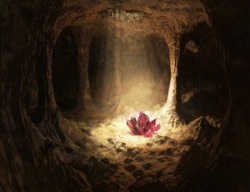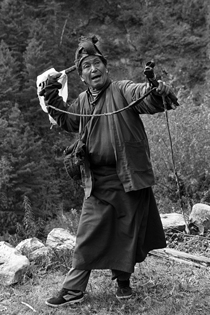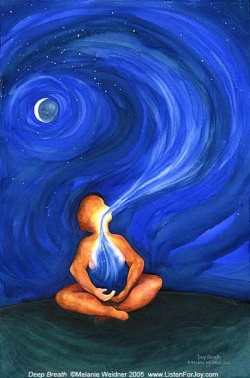The Third-Eye in Buddhism
In Buddhist art and culture, the Urna (more correctly ūrṇā or ūrṇākośa (Pāli uṇṇā)) is a spiral or circular dot placed on the forehead of Buddhist images as an auspicious mark. It symbolizes a third eye, which in turn symbolizes vision into the divine world; a sort of ability to see past our mundane universe of suffering.
As set out in the Lakkhaṇa Sutta or 'Discourse on Marks', the ūrṇā is the thirty-first physical characteristic of Buddha. It is generally thought to be a whorl of hair and be a mark or sign of the Buddha as a mahāpuruṣa or great being.
The device is often seen on sculptures from the 2nd century CE. Sometimes it is represented with a jewel and frequently said to symbolize wisdom.
In the Lalitavistara it is the place from which emits rays of brilliant light.
That is what the Blessed One said. Gratified, the group of five monks delighted at his words. And while this explanation was being given, there arose to Ven. Kondañña the dustless, stainless Dhamma eye: Whatever is subject to origination is all subject to cessation.
And when the Blessed One had set the Wheel of Dhamma in motion, the earth devas cried out: "At Varanasi, in the Game Refuge at Isipatana, the Blessed One has set in motion the unexcelled Wheel of Dhamma that cannot be stopped by brahman or contemplative, deva, Mara or God or anyone in the cosmos." On hearing the earth devas' cry, the devas of the Four Kings' Heaven took up the cry... the devas of the Thirty-three...
the Yama devas... the Tusita devas... the Nimmanarati devas... the Paranimmita-vasavatti devas... the devas of Brahma's retinue took up the cry: "At Varanasi, in the Game Refuge at Isipatana, the Blessed One has set in motion the unexcelled Wheel of Dhamma that cannot be stopped by brahman or contemplative, deva, Mara, or God or anyone at all in the cosmos."
So in that moment, that instant, the cry shot right up to the Brahma worlds. And this ten-thousand fold cosmos shivered & quivered & quaked, while a great, measureless radiance appeared in the cosmos, surpassing the effulgence of the devas.
Then the Blessed One exclaimed: "So you really know, Kondañña? So you really know?" And that is how Ven. Kondañña acquired the name Añña-Kondañña — Kondañña who knows.
Dibbacakkhu — the Divine-eye
18. (9) "Again, with the divine eye, which is purified and surpasses the human, the Tathagata sees beings passing away and reappearing, inferior and superior, fair and ugly, fortunate and unfortunate, and he understands how beings pass on according to their actions thus:
'These worthy beings who were ill-conducted in body, speech and mind, revilers of noble ones, wrong in their views, giving effect to wrong view in their actions, on the dissolution of the body, after death, have reappeared in a state of deprivation, in a bad destination, in perdition, even in hell;
but these worthy beings who were well-conducted in body, speech and mind, not revilers of noble ones, right in their views, giving effect to right view in their actions, on the dissolution of the body, after death, have reappeared in a good destination, even in the heavenly world.'
Thus with the divine eye, which is purified and surpasses the human, he sees beings passing away and reappearing, inferior and superior, fair and ugly, fortunate and unfortunate, and he understands how beings pass on according to their actions. That too is a Tathagata's power...


